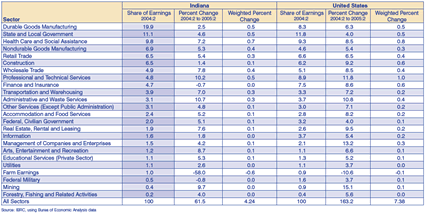Indiana's Share of U.S. Personal Income Continues to Slide
Data released at the end of September by the U.S. Bureau of Economic Analysis show that Indiana’s share of U.S. personal income fell to 1.9 percent. This is the lowest level since 1948, the earliest year for which the bureau has such data.
From a peak of 2.8 percent in the third quarter of 1953, during the Korean War, Indiana has fallen with some regularity to its current low of 1.9 percent (see Figure 1). In 229 quarters, Indiana has grown slower than the nation 58 percent of the time.
Figure 1: Indiana's Quarterly Share of U.S. Personal Income, 1948 through 2005
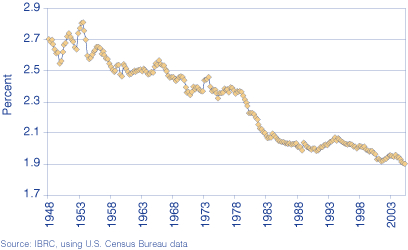
The reasons are well known. The state’s population and economy have not kept pace with national trends as transportation and water improvements, plus air conditioning, made other parts of the nation relatively more attractive than they previously had been.
But why has Indiana failed to keep pace with the nation during the past year? From the second quarter of 2004 through the same quarter this year, Indiana has fallen short of the nation’s rate of growth in personal income (see Figure 2). For the year as a whole, Indiana grew by 4.3 percent (48th of the 50 states) while the nation advanced by 6.5 percent.
Figure 2: Percent Change in Personal Income at Annual Rates
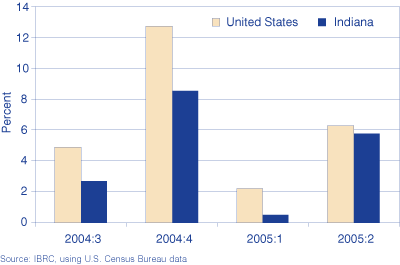
Yes, we are part of the Great Lake states, which together grew by only
4.7 percent in the past year, but what are the specific, detailed factors
behind our slower growth?
Sources of Growth Deficiency
Personal income is composed of three elements:
- Earnings (returns to labor)
- Dividends, interest and rent (returns to capital)
- Transfer payments (largely Social Security and unemployment compensation)
Indiana’s lagging performance in the past year was mainly due to a deficiency in the growth of earnings (see Figure 3). We were virtually even with the nation in two of the three components of personal income, but our earnings grew by only 4.3 percent, while the United States enjoyed a 7.4 percent increase. With earnings accounting for 70 percent of all personal income in both Indiana and the nation, this component carries a very high weight.
Figure 3: Growth Rates by Components, 2004:2 to 2005:2
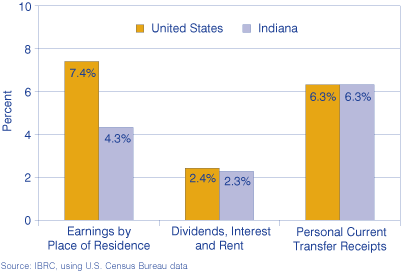
Thus, we have to look more deeply into earnings to find out why Indiana did not keep pace with the nation.
To understand how the changes occur, it is necessary to see these two elements:
- The importance of the sector in the economy
- The percent change of that sector
A sector of little importance may experience a large percent change and the consequences for the whole economy are small. Consider farm earnings in Table 1, where sectors are listed in rank order of importance in Indiana. At 1 percent of the Indiana economy, the dramatic decline of 58 percent in farm earnings accounted for a change of 0.6 percent in total Hoosier earnings. If farm earnings were of greater consequence, such a decline would have been catastrophic.
Table 1: Indiana Share of Industry Earnings, 2004:2 to 2005:2
Similarly, what happens to major sectors is of great significance in the performance of the overall economy. Durable goods manufacturing constitutes nearly 20 percent of Hoosier earnings. However, the growth of merely 2.5 percent in that sector added only 0.5 percent to the total advance of earnings.
It is not the difference between percent changes of individual sectors alone that should occupy our attention. It is the product of the importance of the sector multiplied by its percent change that determines the contribution to change.
The strongest growth rate in the nation’s economy was the 15 percent increase in earnings from mining activities. But, because mining constitutes less than 1 percent of the national economy, the total effect was only 0.1 percent.
Indiana had an increase of 7.2 percent in earnings from health care and social assistance, while the nation grew by 8.5 percent. Yet, because that sector is more important to earnings in Indiana than in the nation (9.8 percent compared to 9.3 percent), the growth rate difference was virtually eliminated in the final results.
Indiana grew faster than the nation in arts, entertainment and recreation. Yet, the difference in share of earnings was so small it wiped out any meaningful consequences for total earnings.
Now we can answer the question: What caused the deficiency in Indiana’s growth of earnings compared to the United States between the second quarters of 2004 and 2005?
The chief problem was in finance and insurance (-0.68 percent). The nation had strong growth at 8.6 percent while Indiana suffered a 0.7 percent decline in earnings (probably due to consolidations). This positive differential for the nation was accentuated by the difference in importance of the sector in the nation (7.5 percent) compared to a lower 4.7 percent in Indiana.
The contributions of each of the 24 sectors under consideration are shown in rank order in Table 2. The total for all sectors is -3.14 percent, which is the difference between Indiana’s growth of 4.24 percent and the nation’s growth in earnings of 7.38 percent. After finance and insurance, the leading negative sectors were professional and technical services, construction and farming. Together, these four most negative sectors accounted for -2.19 percent of the -3.14 percent differential between Indiana and the United States
Table 2: Indiana's Earnings Compared to the Nation
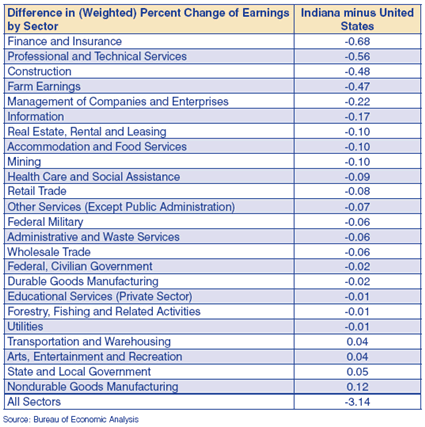
The greatest differential positive contributions to Indiana’s growth came from nondurable manufacturing, state and local government, arts, recreation and entertainment, plus transportation and warehousing.
Note that durable goods manufacturing had a very small negative value associated with it. This is contrary to the popular view that the troubles with Indiana are primarily in this industry. In fact, if one looks at the four leading sectors in Table 1, they account for half (2.1 percent) of the state’s total earnings growth of 4.2 percent.
In Sum
Indiana lagged the nation in the past year because of a sharp decline in farm earnings that was accompanied by a decline in finance and insurance earnings. Perhaps the state’s efforts to attract firms in the insurance industry will be of future benefit. We also had weak performance in professional and technical services because that sector was not large enough to generate significant earnings despite its rapid rate of growth. Finally, it seems that Indiana did not participate in the construction boom that the nation enjoyed during the past year.
Not all of these conditions are subjects for state policy. Some may reflect temporary conditions. Others will correct themselves without intervention. The art of economic development is to know the trends and to identify where action can be effective.
Morton J. Marcus, Director Emeritus
Indiana Business Research Center, Kelley School of Business, Indiana
University

